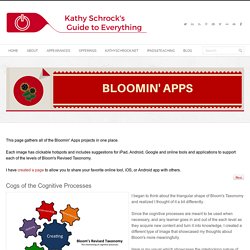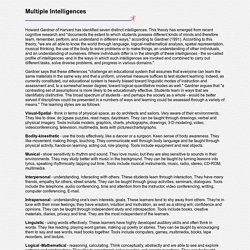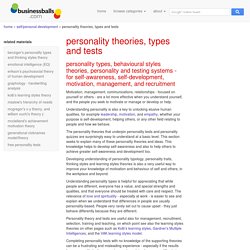

Bloomin' Apps. This page gathers all of the Bloomin' Apps projects in one place.Each image has clickable hotspots and includes suggestions for iPad, Android, Google and online tools and applications to support each of the levels of Bloom's Revised Taxonomy.I have created a page to allow you to share your favorite online tool, iOS, or Android app with others.

Cogs of the Cognitive Processes I began to think about the triangular shape of Bloom's Taxonomy and realized I thought of it a bit differently.Since the cognitive processes are meant to be used when necessary, and any learner goes in and out of the each level as they acquire new content and turn it into knowledge, I created a different type of image that showcased my thoughts about Bloom's more meaningfully.Here is my visual which showcases the interlocking nature of the cognitive processes or, simply, the "Cogs of the Cognitive Processes".
IPAD APPS TO SUPPORT BLOOM'S REVISED TAXONOMYassembled by Kathy Schrock Learning Styles questionnaire. The VARK Questionnaire. Vark learning styles theory. VARK learning styles theory is designed to describe how four distinct types of learners process information.

Based upon the VAK (visual, auditory and kinesthetic) model of learning, VARK learning styles theory was pioneered in 1987 by Neil Fleming. Fleming's contribution to the prior model was to divide the visual learning component into two parts, a symbolic aspect (represented as V) and a text aspect (represented as R). Additionally, Fleming advanced the original theory to supplement the auditory learning and kinesthetic learning components of traditional VAK theory. Suppositions According to the VARK learning styles theory, every individual is predisposed to a preferred learning style, instinctively favouring one of the four styles that the theory describes.
Commonalities While most students express a marked preference for a particular learning style, they are usually not unable to process information even if it is presented in the format of a non-preferred style. Strategies. The Learning Styles Questionnaire. Learning style preferences determine the things people learn and the ease with which they learn them.

They exert a hidden, but powerful, influence on learning effectiveness. The Learning Styles element of the Learning Series highlights individual learning style preferences, equips people to choose learning opportunities, and shows them how to expand their repertoire and become the all-round learners vital to the success of your business. The Learning Styles Questionnaire explores the four Honey and Mumford learning styles: Activists - who are ‘hands-on’ learners and prefer to have a go and learn through trial and error Reflectors - who are ‘tell me’ learners and prefer to be thoroughly briefed before proceeding Theorists - who are ‘convince me’ learners and want reassurance that a project makes sense Pragmatists - who are ‘show me’ learners and want a demonstration from an acknowledged expert.
Which Learning Styles Questionnaire is best for you? Advantages of the 40-item questionnaire. 3.2.6 Identifying Learner Needs. Gardner's Multiple Intelligences. Howard Gardner of Harvard has identified seven distinct intelligences.

How To Be An eTutor. Learning Style Theories. All Students are Created Equally (and Differently.)

The term “learning styles” speaks to the understanding that every student learns differently. Technically, an individual’s learning style refers to the preferential way in which the student absorbs, processes, comprehends and retains information. For example, when learning how to build a clock, some students understand the process by following verbal instructions, while others have to physically manipulate the clock themselves. Birmingham Grid for Learning - Multiple Intelligences (Secondary) Multiple intelligences - howard gardners multiple intelligences theory - visual auditory kinesthetic learnings styles VAK model. Multiple intelligences theory Howard Gardner's Multiple Intelligence Theory was first published in Howard Gardner's book, Frames Of Mind (1983), and quickly became established as a classical model by which to understand and teach many aspects of human intelligence, learning style, personality and behaviour - in education and industry.

Can neuroscientists dispel the myth that children have different learning styles? Over the past few years, there seems to have been a insidious pandemic of nonsense neuroscientific claims creeping into the education system.

In 2013, the Wellcome Trust commissioned a series of surveys of parents and teachers, asking about various types of educational tools or teaching methods, and the extent to which they believe they have a basis in neuroscience. Worryingly, 76% of teachers responded that they used learning styles in their teaching, and a further 19% responded that they either use, or intend to use, left brain/right brain distinctions to help inform learning methods. Both of these approaches have been thoroughly debunked, and have no place in either neuroscience or education. In October last year, I reported on another study that showed that in the intervening time, things hadn’t really improved – 91% of UK teachers in that survey believed that there were differences in the way that students think and learn, depending on which hemisphere of the brain is ‘dominant’. Free VAK visual auditory kinesthetic learning styles test questionnaire. Personality styles, types, theories and psychometrics models, personality tests and quizzes theory.
Personality models on this page The Four Temperaments/Four Humours Carl Jung's Psychological Types Myers Briggs® personality types theory (MBTI® model) Keirsey's personality types theory (Temperament Sorter model) Hans Eysenck's personality types theory Katherine Benziger's Brain Type theory.

Vark.